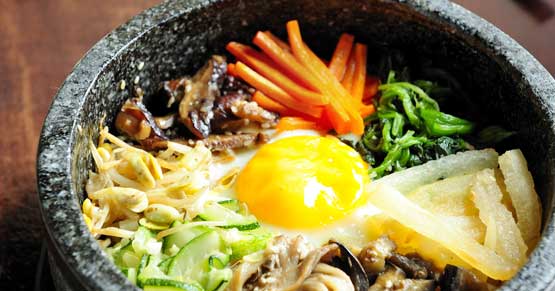Introduction
Korean cuisine is traditionally a very flavorful and healthy cuisine centered around balanced meals with meat or fish, grains, and seasonal vegetables.
A typical Korean meal usually consists of a variety of small dishes called "banchan" that are meant to be shared (kimchi being the most typical and well known). Main dishes are also shared, while each person gets his or her own bowl of rice and a bowl of soup.
While it will probably be necessary to seek out an Asian supermarket or order some ingredients online to make some of the most typical Korean dishes, the extra effort will almost certainly be worth it.

Typical Ingredients
Like in other Asian cuisines, rice is a major component of Korean cuisine. Korean cuisine also uses noodles, such as cellophane noodles made from sweet potato starch called japchae or wheat/buckwheat noodles. Dried mung beans, mung bean powder, rice flour, and sweet rice flour are also used.1
Rice and noodles are often eaten with vegetables, fish, meat, and tofu. Popular
 fresh produce include napa cabbage, lettuce, mushrooms (e.g. shiitake, oyster, and enoki), scallions, ginger, garlic, ginseng, and shiso/perilla leaves as well as Korean radishes, cucumbers, eggplants, and yams (which are all somewhat different than varieties grown in other countries.)
fresh produce include napa cabbage, lettuce, mushrooms (e.g. shiitake, oyster, and enoki), scallions, ginger, garlic, ginseng, and shiso/perilla leaves as well as Korean radishes, cucumbers, eggplants, and yams (which are all somewhat different than varieties grown in other countries.)
Since Korea is surrounded on three sides by water, fish and seafood are a big part of the cuisine, including blue crab, clams, oysters, squid, shrimp, and various fish. As for meat, pork, chicken, and beef are all eaten. Tofu, ranging from extra-soft to firm, is also popular.
Pickled foods have a long history in Korea as pickling was a popular method of preserving food to get through the winter months. Pickled foods are still enjoyed
 today, including vegetables and fish. "Kimchi" refers to any spiced fermented vegetable; cabbage is the most common variety, but kimchi can also be made with radishes, cucumbers, scallions, etc.
today, including vegetables and fish. "Kimchi" refers to any spiced fermented vegetable; cabbage is the most common variety, but kimchi can also be made with radishes, cucumbers, scallions, etc.
Soy sauce, fish sauce, sesame oil, rice vinegar, and chili pastes (e.g. gochujang, a fermented hot chili paste) are used frequently to add flavor to various dishes. Doenjang, or soybean paste, is made of fermented soybeans and is similar to miso in Japanese cuisine. Dried anchovies and seaweed are used to make stock and flavor soups and stews.
Other typical ingredients include dried red dates (also called daechu or jujubes) and rice wine (cheongju and mukgeolli are common for cooking). 2
Typical Korean Recipes
Soup:
Bugeo Guk
Stew:
Kimchi Jjigae
Stew:
Galbi Jim
Main Dish:
Bulgogi
Main Dish:
Bibimbap
Side Dish:
Japchae
Side Dish:
Kimchi
Dessert (Special Occasions):
Chapssaltteok Rice Cakes
Dessert: Maejakgwa
Recommended Read
Growing up in a Korean Kitchen: A Cookbook
This memoir and cookbook includes 250 typical Korean recipes and advice on finding the right ingredients. You won't be disappointed you made the extra effort.






